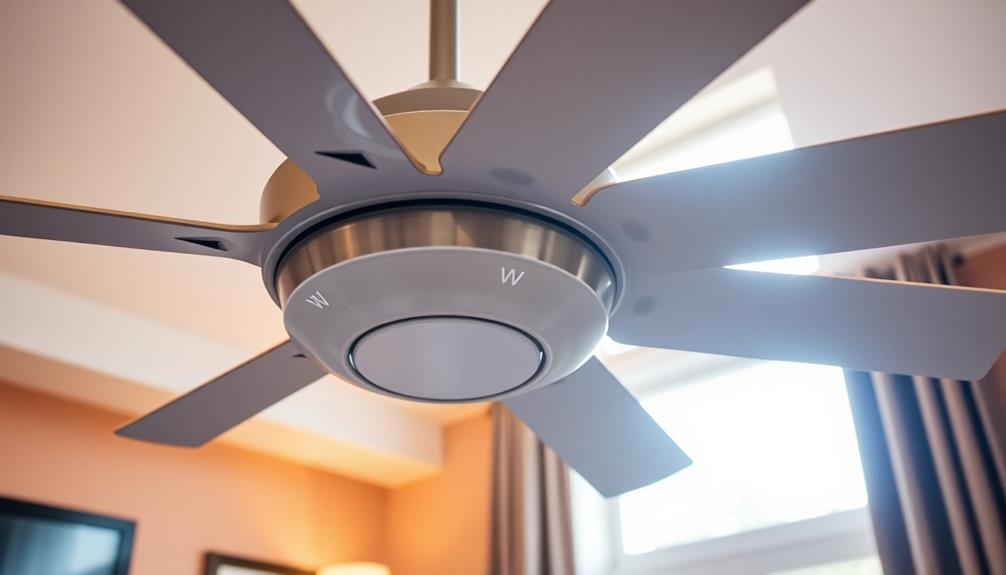Revealing the secrets of ceiling fan wattage helps you maximize efficiency and comfort in your home. You should know that wattage impacts energy bills and fan performance. Factors like fan size, motor efficiency, and speed settings all influence how much wattage a fan requires. By choosing fans with lower wattage ratings but effective airflow, you can save energy. Additionally, proper maintenance, such as cleaning blades and checking electrical connections, guarantees peak performance. Understanding these elements is key to enhancing your living environment. Stick around to explore how these insights can lead to better cooling and energy savings.
Key Takeaways
- Ceiling fan wattage indicates energy consumption, affecting electricity bills and ensuring compatibility with electrical systems.
- Larger fans require more wattage, while high-efficiency motors and blade design can reduce overall energy needs.
- Selecting the right wattage based on room size and ceiling height maximizes airflow and energy efficiency.
- Regular maintenance, such as cleaning and inspecting connections, improves fan performance and longevity.
- Overwattage poses safety risks like overheating, electrical failures, and potential injury hazards; always follow manufacturer guidelines.
Importance of Ceiling Fan Wattage
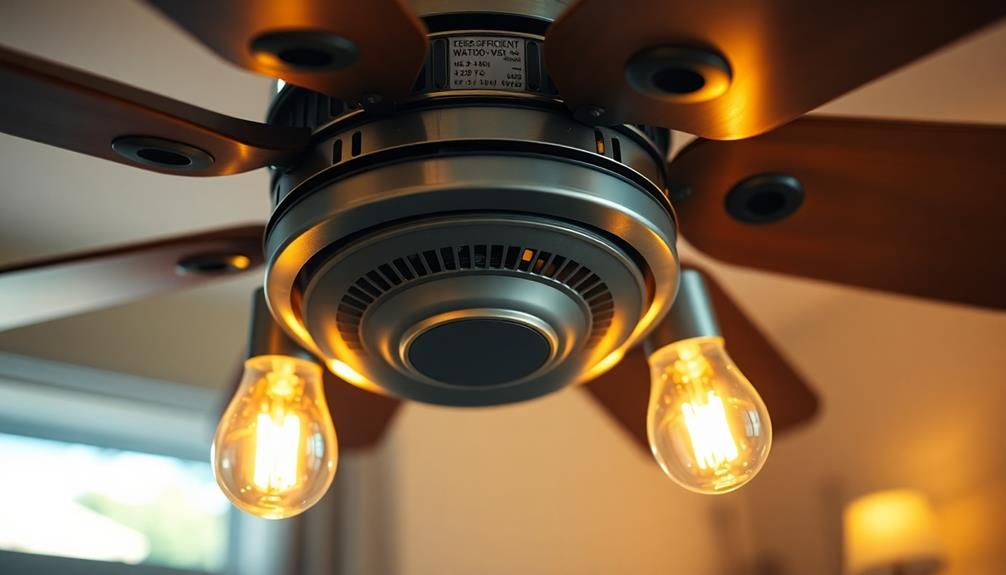
Understanding ceiling fan wattage is essential for making informed decisions about energy consumption and efficiency. The wattage rating indicates how much electrical power a ceiling fan uses, directly influencing your energy bills.
By knowing the wattage, you can ascertain compatibility with your electrical systems, preventing potential hazards like overheating or blown fuses. Additionally, being aware of different wattage levels helps you select the right fan for specific needs—whether it's for general air circulation, cooling, or lighting.
This awareness not only supports energy-saving choices but also enhances the overall performance of your fan in any environment. Ultimately, understanding wattage empowers you to create a comfortable atmosphere while managing your energy consumption effectively.
Factors Affecting Wattage Consumption

Several factors influence the wattage consumption of ceiling fans, impacting their overall performance and efficiency. Understanding these factors helps you choose the right fan for your space.
- Fan Size: Larger fans typically require more wattage to operate effectively. If you need good airflow, consider a fan size that matches your room dimensions.
- Motor Efficiency: Quality motors consume less energy. Investing in a high-efficiency motor will reduce wattage needs while maximizing performance.
- Speed Settings: Higher speeds demand more energy. If you often use the highest setting, be prepared for increased wattage consumption.
Energy Efficiency Considerations
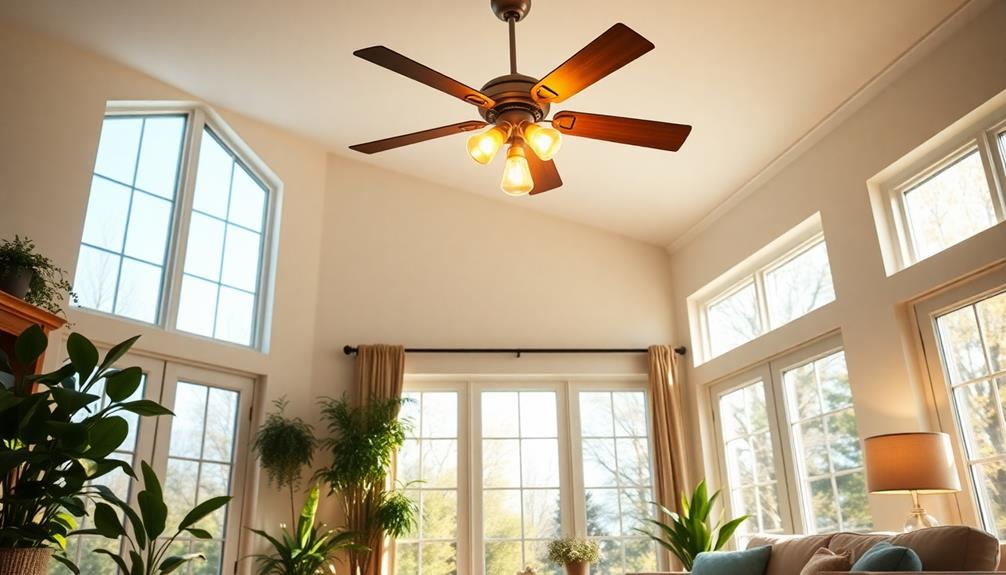
When selecting a ceiling fan, energy efficiency plays a significant role in determining both your energy bills and environmental impact.
You'll want to look for models with lower wattage ratings that still provide effective airflow. Fans with high-efficiency motors and adjustable speed settings can help you save on electricity costs.
Consider opting for LED light kits instead of incandescent bulbs, as they consume less energy and last longer. Consider opting for LED light kits instead of incandescent bulbs, as they consume less energy and last longer. This energy efficiency not only reduces your electricity bills but also helps lower your carbon footprint, contributing to a greener planet. Similarly, embracing eco-friendly choices in other aspects of life, like shopping from the best sustainable fashion brands 2025, can further support environmentally responsible living. By making these small yet impactful changes, you can play a significant role in promoting sustainability.
Regular maintenance, like cleaning the blades and ensuring the fan runs smoothly, can enhance efficiency.
Finally, using your ceiling fan in conjunction with your HVAC system can optimize your energy use, allowing you to enjoy comfort without skyrocketing utility bills.
Make energy efficiency a priority for both your wallet and the planet.
Safety Risks of Overwattage
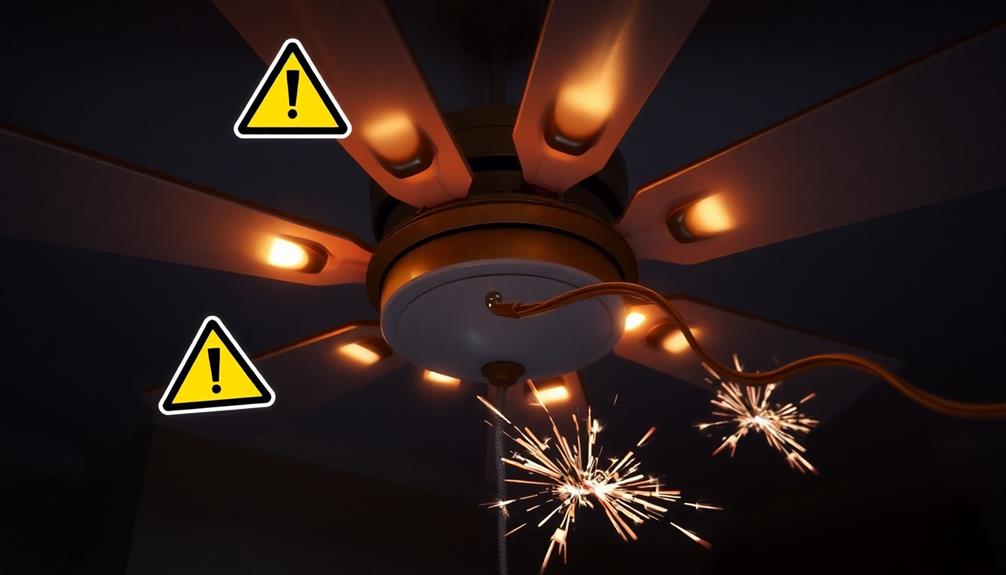
Exceeding the recommended wattage for your ceiling fan can lead to serious safety hazards. When you push your fan beyond its wattage limits, you risk overheating and potential fires.
Here are three key risks to keep in mind:
- Overheating: Higher wattage bulbs can cause the fan's motor to overheat, damaging internal components and creating fire risks.
- Electrical Failures: Overloading the fan can lead to blown fuses or tripped circuit breakers, disrupting your electrical system.
- Injury Risks: High wattage bulbs may shatter, posing risks of injury from glass shards.
Always follow manufacturer guidelines to guarantee safety and maintain your fan's performance.
Keeping within the recommended wattage helps keep your home safe and your ceiling fan running smoothly.
Selecting the Right Wattage
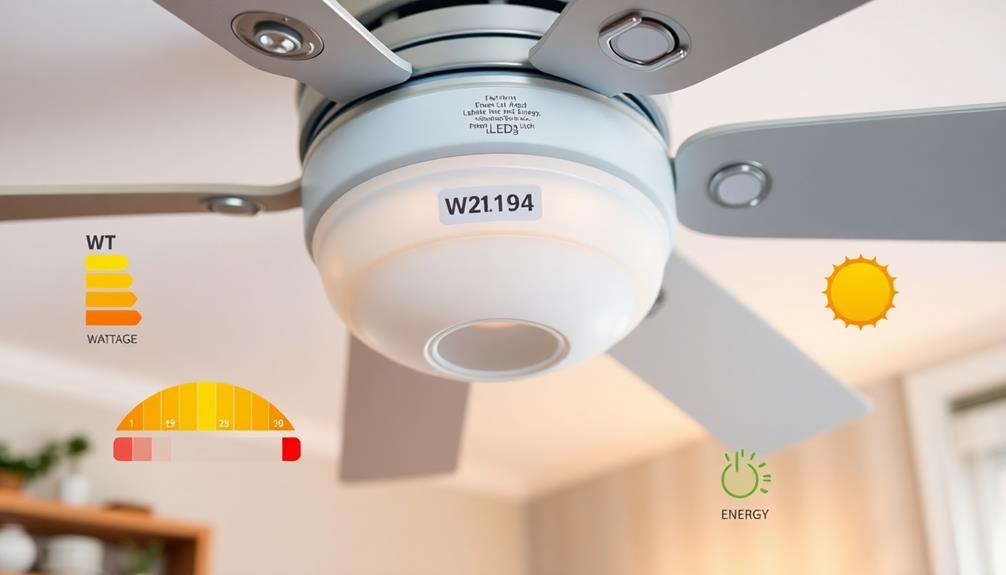
Choosing the right wattage for your ceiling fan is essential for maximum performance and energy efficiency.
First, consider the size of your fan. Smaller fans, like 36-inch models, typically require 10-30 watts, while larger fans, such as those measuring 72 inches, might need 120-150 watts.
Next, think about the room's size and ceiling height. A fan that's too low on wattage may struggle to circulate air effectively.
Also, remember that features like built-in lights increase overall wattage consumption.
Check the product manual, look for labels on the fan, or visit the manufacturer's website to find the exact wattage rating.
Understanding Fan Size Impact
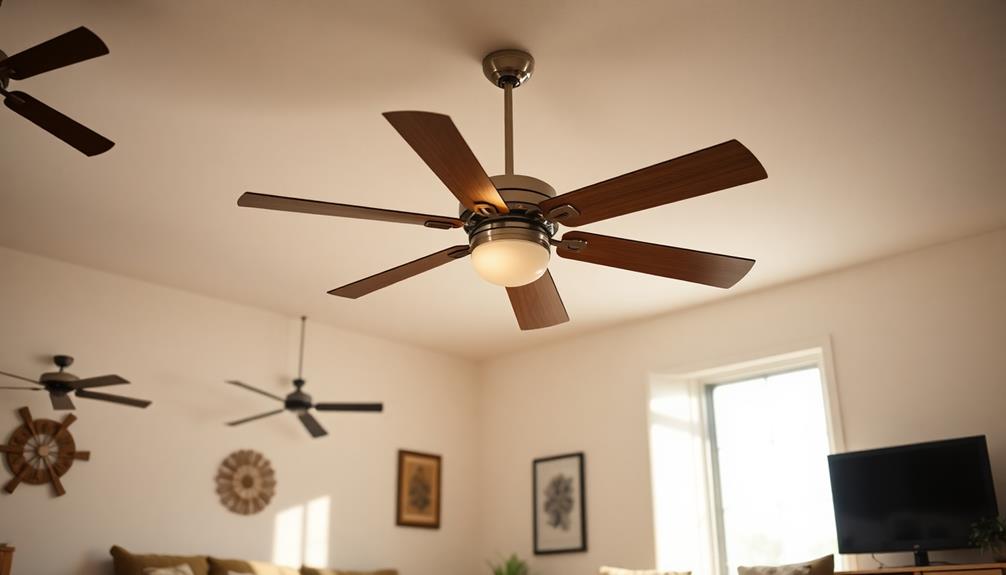
The size of your ceiling fan considerably impacts its wattage and overall performance.
Larger fans generally use more energy due to their greater surface area and the need for a more powerful motor.
Here's how fan size affects wattage:
- Blade Length: Longer blades can move more air, but they also require higher wattage to operate effectively.
- Room Size: A larger fan is necessary for bigger rooms to guarantee adequate airflow, leading to increased wattage needs.
- Motor Efficiency: Bigger fans often come with more robust motors, which can consume more power.
Choosing the right size fan for your space not only enhances comfort but also helps you manage energy consumption effectively.
Maintenance for Optimal Performance
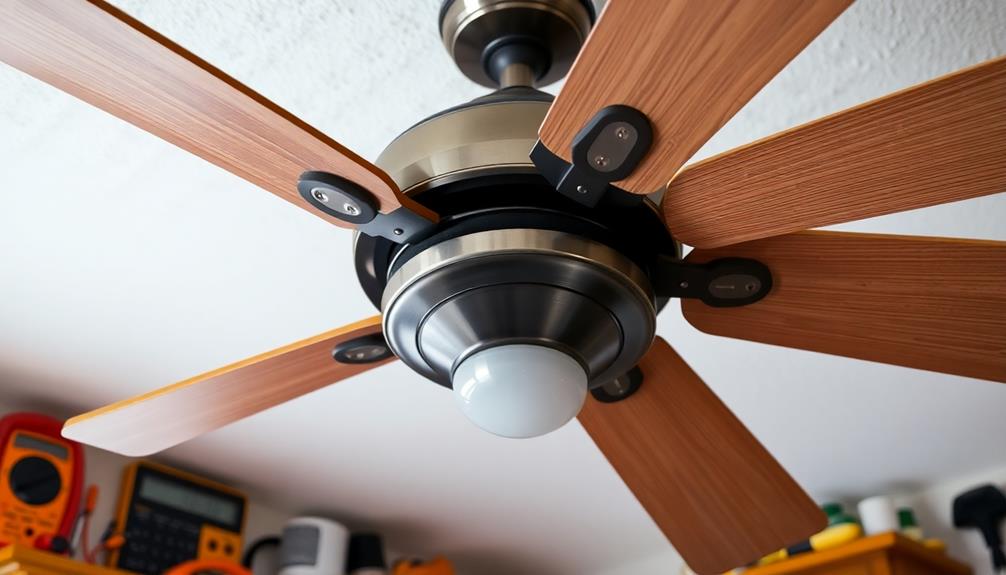
Regular maintenance is essential for guaranteeing your ceiling fan operates at peak performance.
Start by dusting the blades regularly to prevent dirt buildup, which can hinder airflow. Check the motor housing and verify it's clean to maintain efficiency.
You should also tighten screws and bolts to avoid any vibrations during operation. Inspect the electrical connections for wear or damage, and replace any frayed wires immediately.
Lubricate the motor according to the manufacturer's guidelines to keep it running smoothly. Additionally, confirm your fan is installed at least 8 feet above the floor for ideal airflow.
Frequently Asked Questions
How Do I Calculate the Wattage Needed for Multiple Ceiling Fans?
To calculate wattage for multiple ceiling fans, add the wattage ratings of each fan together. Consider room size and desired air circulation, ensuring you're within safe limits for your electrical system to avoid hazards.
Can Ceiling Fan Wattage Impact My Electricity Bill Significantly?
Sure, if you think ceiling fan wattage won't affect your electricity bill, you might as well leave your fridge door open! Higher wattage fans can definitely inflate your bill, so choose wisely and save cash.
Are There Ceiling Fans With Variable Wattage Features?
Yes, some ceiling fans offer variable wattage features, allowing you to adjust energy consumption based on your needs. By selecting different speed settings or using integrated lighting, you can optimize efficiency while enjoying customized comfort.
What Is the Lifespan of a Ceiling Fan Motor Based on Wattage?
You might wonder how long a ceiling fan motor lasts, right? Generally, it ranges from 10 to 20 years, influenced by wattage and usage. Higher wattage may lead to more wear, reducing lifespan.
How Does Ceiling Fan Wattage Relate to Environmental Impact?
Ceiling fan wattage directly impacts energy consumption, influencing your carbon footprint. By choosing energy-efficient models with lower wattage, you can reduce environmental harm while enjoying comfort, ultimately contributing to a more sustainable lifestyle.
Conclusion
In conclusion, understanding ceiling fan wattage is essential for maximizing comfort and efficiency in your home. Did you know that a typical ceiling fan uses about 70-80 watts on high speed, but energy-efficient models can use as little as 15 watts? By choosing the right wattage, you not only save on energy bills but also guarantee peak performance. So, keep these insights in mind, and you'll find the perfect ceiling fan that fits both your needs and your budget.
